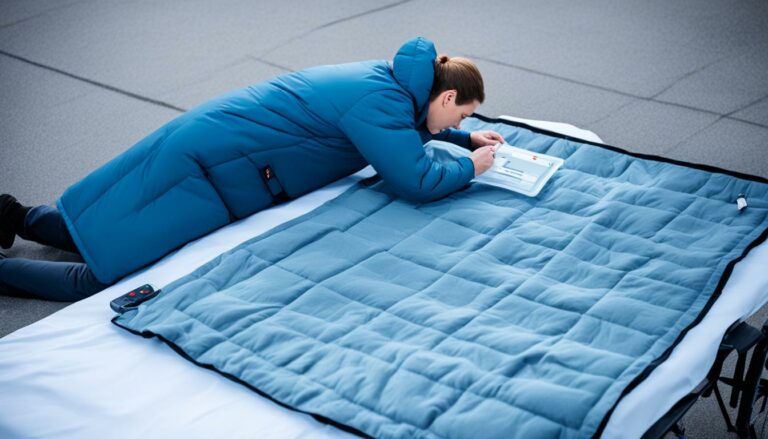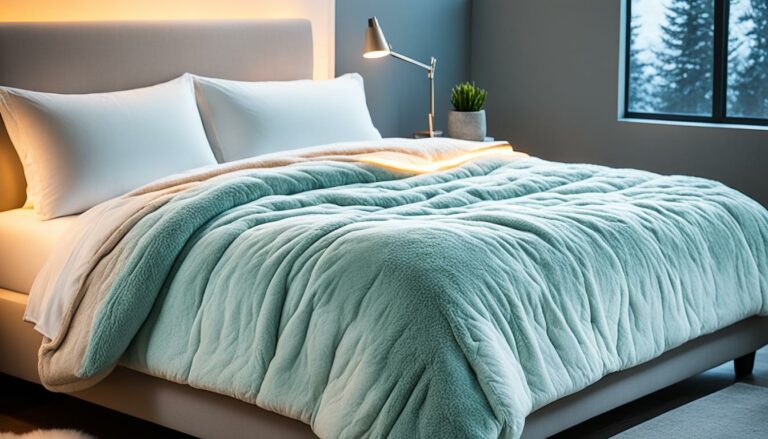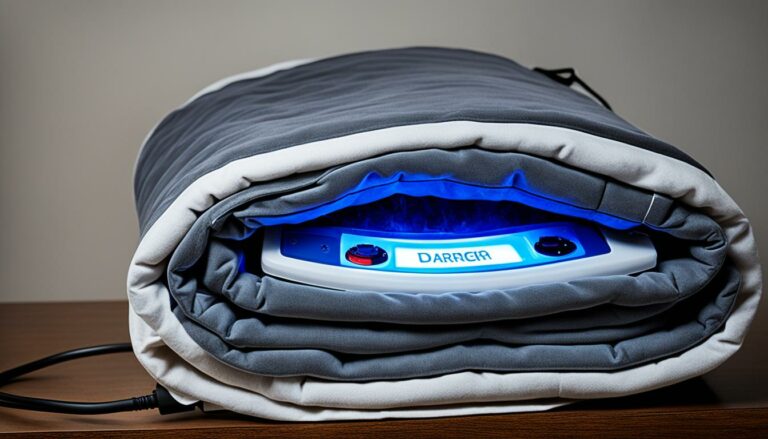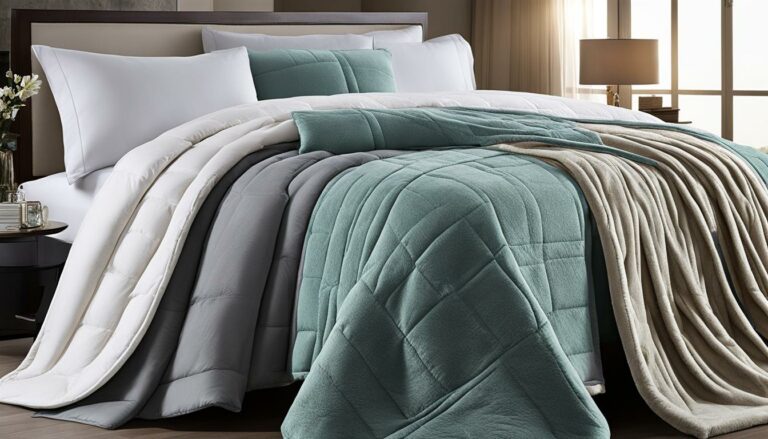Heated Blankets Bad for You? Uncover the Truth!
Eric Christie stands as a luminary in the bedding industry, with a career spanning nearly four decades since the early 1980s. His journey through the world of bedding has seen him wear many hats – a manufacturer, designer, and retailer, showcasing his versatility and expertise in Read more...
pillowsandbedsheets.com and its partners may earn a commission if you purchase a product through one of our links
Heated blankets are a cozy and comforting way to stay warm during chilly nights. However, it’s important to be aware of the potential health risks and dangers associated with their use. While electric blankets, when used correctly, don’t usually pose significant health or safety risks, there are a few things to consider before snuggling up.
One concern is the exposure to electromagnetic fields (EMFs) emitted by electric blankets. Some studies suggest that prolonged exposure to EMFs may increase the risk of cancer and lead to pregnancy complications and decreased fertility in men. Although the evidence is not conclusive, it’s crucial to be cautious if you have these concerns.
Another risk is the possibility of fire hazards and burns. Old or damaged electric blankets can be a fire hazard, causing accidents and property damage. Additionally, individuals with reduced sensation or neuropathy, children, and the elderly are at higher risk of burns if they come into contact with a hot blanket.
To ensure your safety, make sure to inspect your electric blanket for any signs of damage before using it, and always follow the manufacturer’s safety guidelines. It’s also a good practice to turn off the blanket when not in use or before falling asleep.
If you have concerns about the safety of using a heated blanket, there are alternative options available to keep warm at night. Traditional non-electric blankets made from warm materials such as cotton, wool, cashmere, or fleece can provide a cozy and safe alternative. Layering blankets and using thick bed sheets made from warm materials can also help retain warmth. Other alternatives include using hot water bottles or heat pads, wearing socks and head coverings, and ensuring a draft-free bedroom.
Key Takeaways:
- Electric blankets may have potential health risks, including EMF exposure and fire hazards.
- Studies suggest a possible connection between EMF exposure and cancer, pregnancy complications, and decreased fertility.
- Old or damaged electric blankets can be a fire hazard, and there is a risk of burns, especially for vulnerable individuals.
- Inspect your electric blanket for damage, follow safety guidelines, and turn off the blanket when not in use.
- Consider alternative options such as non-electric blankets, hot water bottles, or heat pads for warmth and safety.
Potential Health Risks of Electric Blankets
The use of electric blankets has been associated with potential health risks. One concern is the exposure to electromagnetic fields (EMFs), which can enhance the risk of cancer, pregnancy problems for women, and decreased fertility in men. While conclusive evidence linking electric blankets to cancer is lacking, it is recommended to reduce EMF exposure, especially for extended periods of time. Pregnant women are advised to avoid using electric blankets due to potential complications. Those with diabetes, reduced sensation, or circulation issues, as well as older adults and individuals with dementia, should also be cautious when using electric blankets due to the risk of burns. It is important to consult with a healthcare professional if there are concerns about the safety of using heated blankets.
Risks Associated with Electric Blankets
Electric blankets come with a range of potential health concerns that should not be ignored. The primary concern revolves around the electromagnetic fields (EMFs) emitted by these blankets, which can have detrimental effects on the body. Prolonged exposure to EMFs has been linked to an increased risk of cancer, pregnancy complications, and decreased fertility in men. Although the evidence is not yet conclusive, it is important to exercise caution and limit exposure to EMFs whenever possible.
In addition, several specific groups of people should be particularly aware of the potential risks of electric blankets. Pregnant women are advised to avoid using electric blankets due to the potential harm they may cause to the developing fetus. Individuals with diabetes, reduced sensation, or circulation issues are also at higher risk of burns and should use electric blankets with caution or consider alternative heating methods. Older adults and those with dementia may have difficulty regulating the temperature settings on electric blankets, leading to overheating or exposure to excessive heat.
“Exposure to electromagnetic fields (EMFs) from electric blankets has been associated with increased cancer risk and pregnancy complications.”
It is crucial to prioritize your health and safety when using electric blankets. If you have any concerns, it is advisable to consult with a healthcare professional to evaluate the potential risks based on your specific circumstances.
| Risk | Who is at Risk |
|---|---|
| Increased cancer risk | General population, prolonged users |
| Pregnancy complications | Pregnant women |
| Decreased fertility | Men |
| Burns | People with diabetes, reduced sensation, or circulation issues |
| Overheating | Older adults, individuals with dementia |
Fire Hazards and Burns
One of the primary risks associated with using heated blankets is the potential for fire hazards. Old or damaged electric blankets can pose a significant risk of fires, with nearly 500 fires caused yearly by electric heating blankets and heating pads. The majority of home fires are caused by blankets that are 10 years or older.
Additionally, there is a possibility of burns, especially for children, the elderly, and individuals with reduced sensation or neuropathy. Direct contact with hot elements or prolonged exposure to high heat can lead to burns and skin injuries. It is crucial to inspect electric blankets for any signs of damage before use to prevent accidents.
“Leaving a blanket on for too long, especially when you’re sleeping, can cause burns,” warns Dr. Mary L. Gavin, senior medical editor for KidsHealth.org.
It is important to follow safety guidelines to prevent unsafe outcomes. Here are some measures you can take to reduce the risk of fire hazards and burns:
- Never use an old or damaged electric blanket.
- Keep the blanket away from flammable materials such as curtains or bedding.
- Avoid folding or bunching the blanket when in use as it can cause overheating.
- Do not leave the blanket unattended or keep it turned on while you are sleeping.
- Keep the blanket flat and avoid covering it with additional blankets or pillows.
- Ensure children and individuals with reduced sensation are supervised and cautious when using heated blankets.
By practicing these safety measures, you can minimize the risk of fire hazards and burns, ensuring a safe and comfortable experience with your heated blanket.
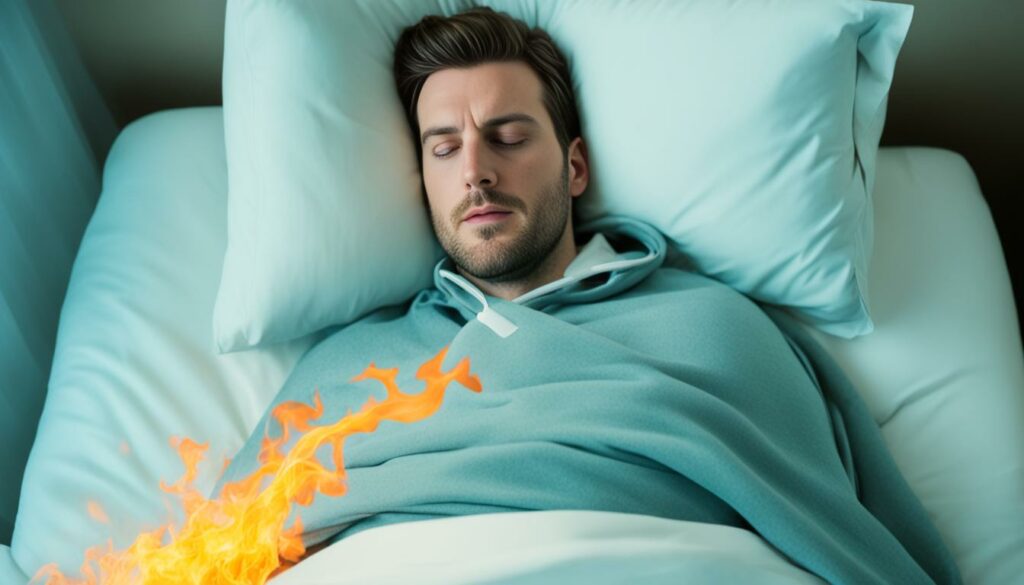
Using Heated Blankets Safely
While heated blankets can provide warmth and comfort, it is crucial to prioritize your safety when using them. By taking certain precautions, you can minimize the risks associated with heated blankets.
Assess the condition of your blanket
Before each use, carefully inspect your heated blanket for any signs of damage. Look for frayed wires, exposed elements, or any other defects. If you notice any issues, it’s important to refrain from using the blanket to prevent potential safety hazards.
Turn off when not in use
Make it a habit to switch off your electric blanket when you’re not using it, especially when you’re leaving the room or going to sleep. This simple step can significantly reduce the risk of fire accidents and electrical malfunctions.
Avoid using on certain furniture
It’s important to avoid using electric blankets on adjustable beds, water beds, pull-out sofas, or recliners. These types of furniture can potentially cause fraying or pinching of cords and wires, which may lead to damaged or exposed electrical components.
Follow safety guidelines
Always refer to the manufacturer’s instructions and safety guidelines provided with your heated blanket. The guidelines usually include specific recommendations on temperature settings, duration of use, and care instructions. Following these guidelines helps ensure the safe operation of your blanket.
Proper storage
Please store your heated blanket carefully when not in use. Make sure it’s stored in a cool, dry place, away from moisture and direct sunlight. This helps maintain the integrity of the blanket and prevents any potential damage or deterioration.
“Taking precautions and following safety guidelines can help ensure the safe and enjoyable use of heated blankets.”
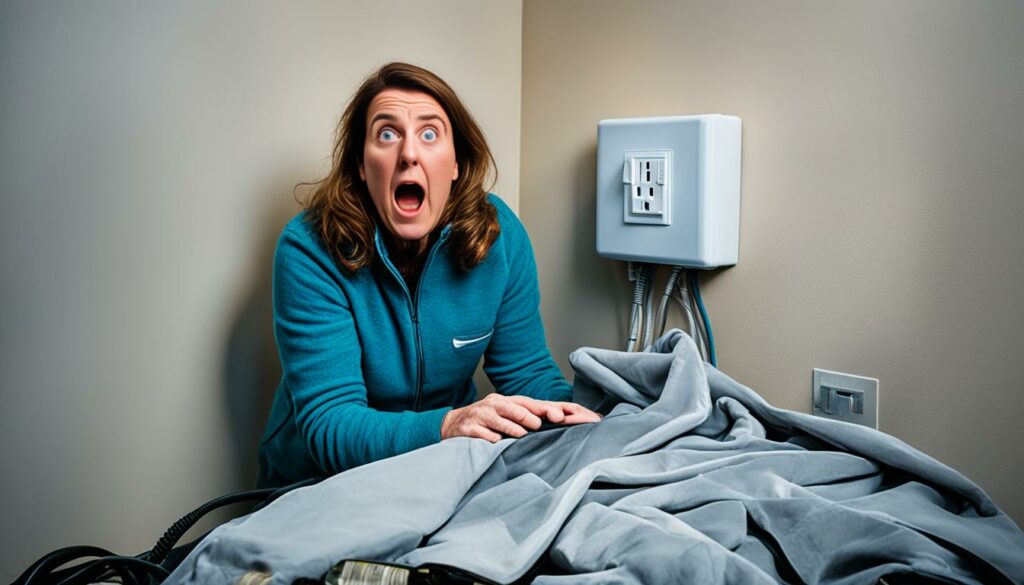
| Drawbacks of Heated Blankets | Precautions for Safe Use |
|---|---|
| 1. Potential health risks such as EMF exposure and its connection to cancer, pregnancy complications, and decreased fertility | 1. Assess the condition of the blanket before use |
| 2. Fire hazards and the risk of burns, especially if the blanket is old or damaged | 2. Turn off the blanket when not in use |
| 3. Electrical malfunctions due to improper use and storage | 3. Avoid using on certain furniture |
| 4. Limited temperature control and potential discomfort | 4. Follow safety guidelines provided by the manufacturer |
Alternatives to Heated Blankets
If you have concerns about the safety of using heated blankets, there are several alternatives you can consider to stay warm at night. Traditional non-electric blankets made from warm materials like cotton, wool, cashmere, or fleece are not only cozy but also safe options to keep you comfortable throughout the night.
Another option is to layer blankets and use thick bed sheets made from warm materials. This helps to trap heat and retain warmth, providing an effective way to stay cozy during colder nights. Additionally, using hot water bottles or heat pads can provide targeted warmth to specific areas of your body, giving you a comforting sleep experience.
Wearing socks and head coverings can also help you maintain body heat by preventing heat loss from these areas. Additionally, ensuring your bedroom is draft-free by sealing any gaps or cracks in windows and doors can help create a warm and snug sleeping environment.
It’s important to explore these alternatives and find the option that best suits your needs to ensure a safe and comfortable night’s sleep without relying on heated blankets.
FAQ
Are heated blankets bad for you?
Heated blankets can pose potential health risks if not used properly. It is important to understand the potential dangers and take necessary precautions.
What are the potential health risks of using heated blankets?
The main concern is the exposure to electromagnetic fields (EMFs), which may increase the risk of cancer, pregnancy complications, and decreased fertility in men. Although the evidence is not conclusive, it is recommended to minimize EMF exposure.
What are the dangers of using heated blankets?
The primary dangers include the risk of fire hazards and possible burns. Old or damaged electric blankets can cause fires, and there is a potential for burns, especially for children, the elderly, and individuals with reduced sensation or neuropathy.
How can I use heated blankets safely?
To use heated blankets safely, inspect them for any signs of damage before use, turn them off when not in use and before falling asleep, and avoid using them on adjustable beds, water beds, pull-out sofas, or recliners. Following safety guidelines and proper storage is crucial.
What are the alternatives to heated blankets?
There are several alternatives to stay warm at night, such as using traditional non-electric blankets made from warm materials, layering blankets and using thick bed sheets, using hot water bottles or heat pads, wearing socks and head coverings, and ensuring draft-free bedrooms.
Eric Christie stands as a luminary in the bedding industry, with a career spanning nearly four decades since the early 1980s. His journey through the world of bedding has seen him wear many hats – a manufacturer, designer, and retailer, showcasing his versatility and expertise in Read more...


